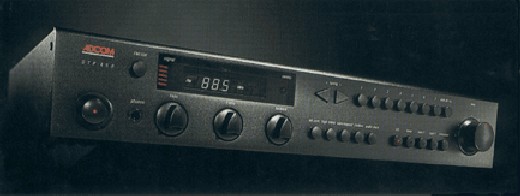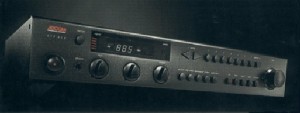From the 1970’s to the mid-1980’s receivers were thought to be the perfect combination for most any stereo setups. The separates market was reserved for the high-enders only. Then, in the mid-80’s Adcom rattled the affordable industry with a beautiful, clean design, power, and quality acoustics. A signature of its new vision was the integration of the preamplifier and tuner rather than the standard integrated amplifier. The reasoning was straightforward, the preamp and tuner could easily share the power source without sound degradation and at a definite cost savings.
Adcom became the darling of the affordable audio industry across the country. Independent dealers lined up to carry the entire line up, so different and sharp was the look. On top of that, the three amplifiers were brutes for their time. In the premier issue I extolled the virtues of the intro model the GFA-535 for it’s sledgehammer ability to pound out difficult loads.
Adcom GPT-450 review
A few months back I acquired the GTP-450 preamp to match up with the GFA-535. I had investigated and tried out a variety of pre-amps. I found most to be a bit harsh when hooked up to the 535. The GTP-545, I hoped being of the same family would smooth out the rough edges of the GFA-535. In addition, the GPT-450 was the first Adcom preamp with a remote control, something I need as my wife will call out from time to time as I listen both casually and during reviews.
The Adcom GTP-450 is divided into two parts across its front face. The upper half is dedicated to the tuner section. From left to right: FM/AM button, the display window with five narrow horizontal bars demonstrating signal strength. Next comes left and right arrow shaped buttons for tuning, followed by seven station memory buttons and a shift button. Thus 14 stations can be held for those that have a tendency to surf broadcasted music.
The lower half focuses on the pre-amplifier section. It includes the power button, headphone jack, bass, treble and balance knobs. Next comes a series of sound processing buttons including the high cut, contour, and audio mute. Next is the source buttons starting with CD, Tuner, Tape One, Tape Two, Video/Aux, Finally, sits the volume control dial. It has a very heavy action to it. Unlike preamplifiers such as Harman/ Kardon where just a tiny movement increases or decrease volume level, the GTP-450 requires a significant adjustment. This takes a bit of getting used-to, but once accomplished I find it much easier to work with.
The backside is separated into three vertical sections. On the left is the antennae cluster, including a 75 Ohm coax connection, something I am a fan of. The middle section consists of the RCA input and outputs with the left channel on top. The right section is for power including one switched and one unswitched ac plugin.
The remote is quite basic, a welcome respite from the myriad of buttons on most home theater audio equipment. A nifty feature for those who would use both the remote and volume knob is that when increasing/ decreasing the volume with the remote, the volume knob moves in accordance. This protects against a nasty volume surprise. The downside is that each click of the button moves the volume too far in my opinion, making precise adjustment difficult at best.
Listening Adcom GPT-450
The 500 series Adcom amps are considered to be a bit noisy, especially the monster 200wpc GFA-555. However, the Adcom pre-amps were designed it seemed to soften the amplifier sound. The GTP-450 is no exception. The noise floor dropped appreciably, the soft hissing during gaps in songs all but disappeared. Normally, this filtering would negatively affect the higher frequencies such as cymbal crashes. I compared this sonic difference up against my home theater receiver, the Harman/Kardon AVR-75 in a preamp configuration. After some general comparing I hit upon a longer musical comparison listening to The Who’s classic Quadrophenia. The wonderful engineering mix by bassist John Entwistle allows for many high frequency passages, from Pete Townshend’s synthesizers, to the background ocean waves. The Adcom did an impressive job of eliminating the noise all the while leaving the music intact. I could detect only the most minor of filtering. The HK receiver left the noise intact, not surprising considering it was designed for the impact sounds of home theater.
Another tonal quality imparted is a slight warmness, something I have a tendency to enjoy since I spent so many years using HK separates. Jazz-rock music seems to benefit the most from the warmness. Xylophones and reed instruments project the most coziness. This was quite apparent in listening to the cd Finesse by Images. I noticed my head slightly rocking in pleasure to the sound produced. Vocals also responded in warmer tones, with Melissa Etheridge leading the way, with her edgy gravel diggings from the deeper recesses of her throat.
The downside of the warmness comes with music that has been over-engineered towards soulfulness. Enya’s Watermark, contains passages that tended to cause a bit of reverberation. Acoustic guitar solos occasionally gave off midbass warmth akin to a musician playing in a room with hollow walls. Changing speaker placements only moved the pitch higher or lower, but didn’t change the overall acoustical effect.
Conclusions
The Adcom GPT-450 is a worthy member of the 1980’s series that put Adcom at the forefront of quality affordable gear. It’s warmness should be noted when pairing with amplifiers. Thus, it is best matched with a solid-state amplifier that is dryer and more technical. Musical amplifiers may exaggerate the warmness especially to those who favor jazz or acoustic popular music. For those with an Adcom amplifier, it is an excellent match that brings out a power-based sound touched with a warm cozy tint.
Associated Equipment:
- Adcom GFA-535 Amplifier,
- Harman/Kardon AVR 75 Receiver (as a preamp)
- Toshiba SD-K750 DVD Player
- Apple iPod 60gig iPhoto
- Totem Mite Speakers
from affordableaudio


